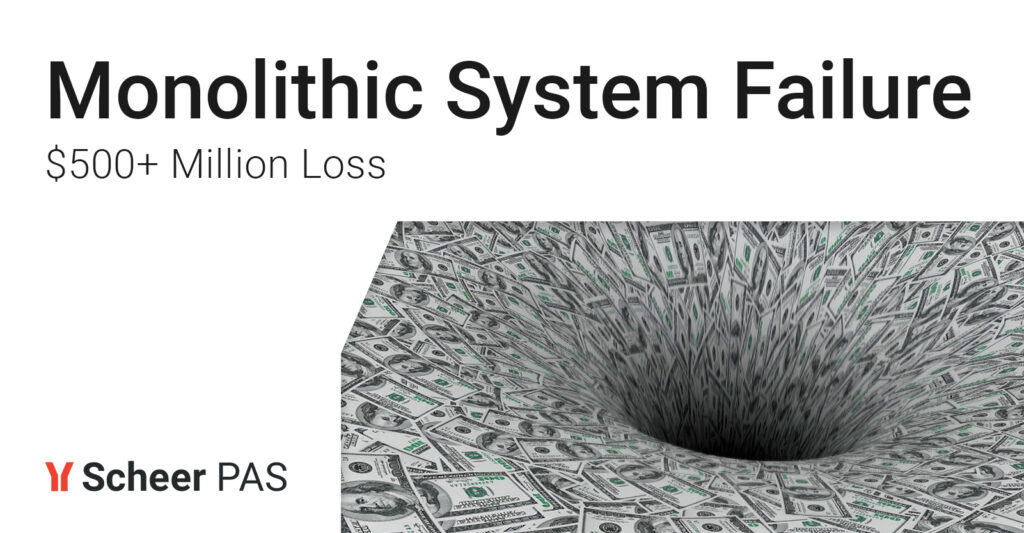$500+ Million Loss? Top 3 Examples of Failed Monolithic Systems That Nearly Destroyed Companies

It is literally almost impossible to imagine a company of any size which would not profit from modernization and digitization of its business model. Inefficiencies are unavoidable and their mitigation through already existing systems, Excel sheets, memos, mails, and word documents seem to be marginal at best. What’s the alternative to unorganized mess of legacy systems?
Some companies seek an answer to this question in monolithic unified systems which can indeed provide solutions for some of the aforementioned problems. Nevertheless, these types of systems carry a hidden burden which proved too costly for 3 companies which could have avoided losses up to $500 million, but they have not. These are their stories.
1. Unripe Avocados

One of the largest distributors of fresh Avocados called “Mission Produce” has a clear focus in their work which is to deliver just-ripe avocados year-round to their customers. After the COVID crisis, Mission Produce has decided to use a well-known monolithic ERP system just to keep its clients supplied. In November of 2021, they turned on their new ERP system and its performance problems and lack of modularity provided a lot of things for Mission Produce but just-ripe avocados were not a part of that.
Slow response times of modifications that were necessary in the system caused delays in their automated customer invoicing. CEO Stephen Barnard told investors “Despite the countless hours we spent planning and preparing for this conversion, we nevertheless experienced significant challenges with the implementation…”. During the delay, Mission Produce had to hire a third-party consultant just to sort out the new ERP system at a cost of $3.8 million over the period of nine months.
Even though it is difficult to give a precise cost of the ERP failure of the implementation of monolithic ERP system, just a $22.2 million year-on-year drop in gross profit should provide enough information.
Why did this happen?
Monolithic systems often require intensive update processes and as a result of their architecture, can provide cascading failures that require intensive management. Microservices and composable applications provide the needed agility to handle changes and solve the problems with next to no downtime.
2. Submerging below the digital world

Vehicle management company “Leaseplan” had an initially successful SAP deployment at its Austrian subsidiary. Therefore, they have commissioned a new partner to develop a new SAP-based Core Leasing System which should have become the heart of the group’s IT transformation across all the markets that they were present in.
After the initial phase and the first quarter of usage, the monolithic nature of the SAP system, according to the Leaseplan themselves, hindered its ability to make incremental product and service improvements at a time of accelerated technological change. They decided to build a modular system using third-party components integrated with their own systems, which proved even more difficult considering the complexity of integration.
This unfortunate event cost Leaseplan more than €92 million only in project costs. The largest problem of the new SAP-based Core Leasing System that they tried to integrate was the inability for their markets to migrate to it considering the difference in usage between the new system and their previous number of systems. Monolithic systems proved unfit for the emerging and ever-changing digital world.
What was missing?
Integration of the new system with legacy and third-party systems simply requires a non-invasive and feasible approach. API management is one of the ways in which the development of the new systems can be sped up and integrated with legacy systems alongside third-party solutions. For the companies that are reliant on some third-party applications or entire systems, API management is a must when beginning the journey towards becoming a real composable enterprise.
3. Low prices, paid pricely

One of the largest retailers in Europe (and a huge market player worldwide), Lidl, had a noble plan of implementing a monolithic system for their own record-keeping. Another German company was supposed to develop the ERP system and implement it in the shortest time possible. The project of development and implementation began in 2011, and by 2018, Lidl was still without the finished product and the benefits that the new system should have brought them.
In 2018, Lidl scrapped the project and reported a loss of nearly $500 million. The problem was in the novelty of Lidl’s record keeping. They have based their inventory systems on the price they pay for goods, unlike their competition that base their systems on the retail price they sell the goods for. The inability to foresee this difference, and later to modify already developed monolithic system in time proved to be of a great cost for Lidl.
Another thing that slowed down the development of the new system was the huge turnover in the executive ranks of Lidl’s IT department because of the complexity of integration and disconnection with the other departments during the development phase. What a recipe for ERP disaster.
How could you avoid this?
Quirks and novelties in business processes of certain companies often create huge gaps between their operative, and IT departments. Even such simple misunderstandings can lead to catastrophic results for any company. That is why the creation of citizen developers in the company and building a bridge between IT and operational departments is crucial for any system implementation. Monolithic systems often force companies to overwork their IT departments which can lead to such disasters as the one Lidl faced. Low-Code development for fusion teams consisting of both IT and other departments cannot just lead to more rapid development and customization but can mitigate any potential for misunderstandings and the lack of transparency.



